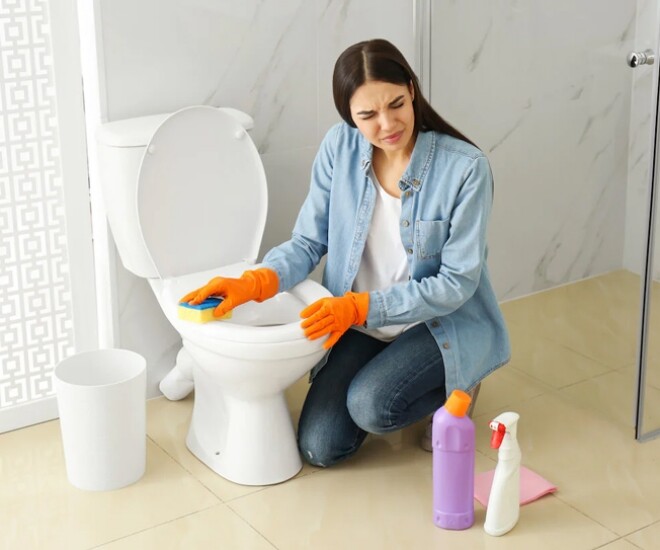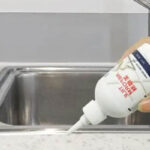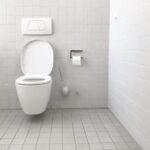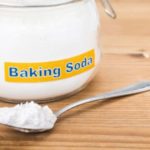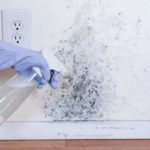I. Cleaning the Bathroom
To prevent the growth of mold, in addition to keeping the bathroom well-ventilated, you can also use some simple tips to clean the bathroom:
1. Deal with moldy silicone
When the bathroom is not kept dry, silicone can be attacked by mold. If your silicone has been moldy for a long time, try diluting bleach with water in a 1:100 ratio.
Use a paper towel to absorb this solution and apply it to the moldy area, leaving it for about 1 hour (if the mold is heavy, you can leave it longer). You will see the mold disappear magically!
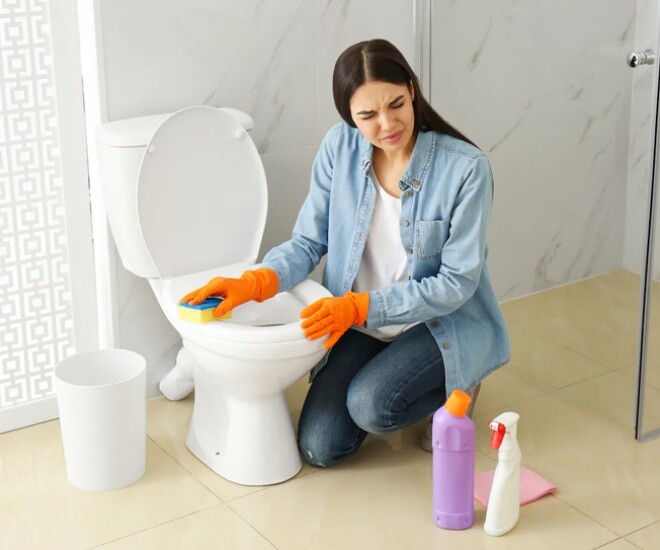
2. Clean mirrors and faucets
Mirrors, glass, and faucets are places prone to water stains. After just a few months, they can become cloudy. To fix this, mix citric acid or lemon juice with water, spray it on the stained areas, and then cover with a damp cloth or plastic wrap for about 30 minutes.
The citric acid will neutralize the water stains without needing to scrub hard. Note that you should not use a hard brush as it may scratch and make the surface dirtier.
3. Floors and walls
If the bathroom floor or walls have pink stains, it could be due to yeast or bacteria. If not addressed promptly, this can lead to health risks. Flush the bathroom with hot water above 50 degrees Celsius after each use for about 5 seconds to kill mold, while maintaining ventilation to reduce humidity.
4. Clean the showerhead
The showerhead drain is often overlooked and is a place where mold can grow. You can dissolve sodium percarbonate (also known as oxygen powder) in water and soak the showerhead for about 30 minutes. Then, simply use a soft brush to scrub it to avoid showering in dirty water.
Alternatively, you can use baking soda mixed with white vinegar, soak the showerhead in this solution overnight, and then scrub it with a brush the next day, rinsing it with clean water.
5. Toilet
The toilet is a place that is frequently used and easily soiled. If left uncleaned for just a week, the toilet can develop an unpleasant odor and stains. To keep the toilet clean, simply use white vinegar and a little baking soda to scrub it; this method is both effective and economical.
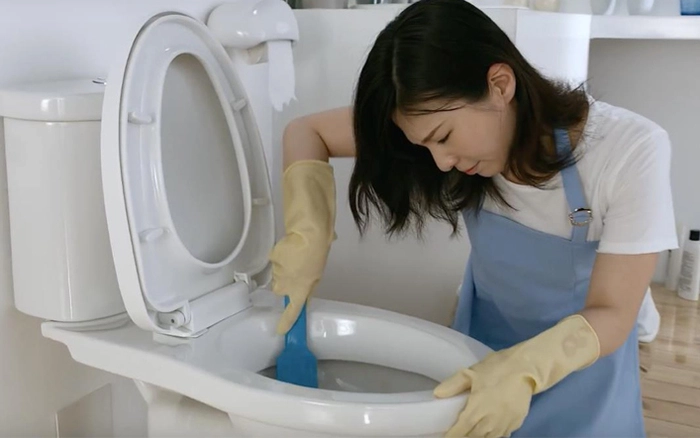
II. Kitchen Cleaning Tips
For families who cook frequently, cleaning up after cooking is very important. Otherwise, cleaning the drain, range hood, and gas stove at the end of the year will become a challenge. Maintain the habit of sanitizing tools like cutting boards and rice cookers to ensure food safety.
Here are some effective kitchen cleaning tips to prevent bacteria and odors.
1. Clean the drain
If not cleaned regularly, the drain can easily become a breeding ground for mold and odors, even attracting flies and cockroaches. At this point, you can put a small spoonful of baking soda into the drain, then add white vinegar and let it sit for 30 to 50 minutes to remove stains and unpleasant odors. Note that if the drain is made of soft material, avoid using hot water as it may cause cracks.
2. Clean the stove
The stove regularly has to “endure” grease and food splatters. For easy cleaning, you can sprinkle a layer of baking soda on the stove surface, wait about 3 minutes until the oil is absorbed into the powder, then dampen a cloth with warm water, wring it out, and wipe away the mess.
If using a gas stove, place the burner in a pot of water, add a large spoonful of baking soda, boil for about 10 minutes, and then use a sponge to wipe it clean.
3. Clean the range hood
The range hood is a nightmare when it comes to cleaning. For effective cleaning, dissolve percarbonate (oxygen powder) in hot water and soak parts like the oil cup and filter for about 1-2 hours. You won’t need to scrub hard, yet you’ll be able to restore shine to the range hood.
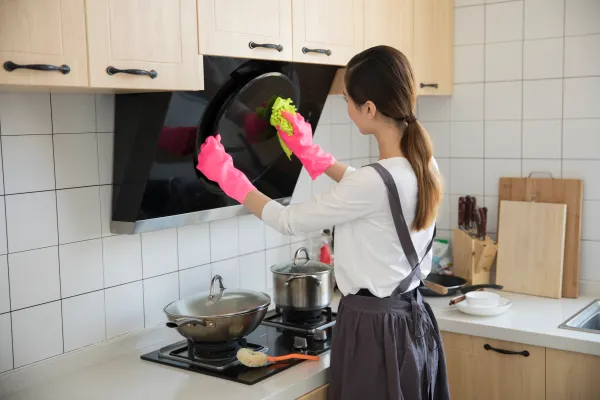
4. Clean the rice cooker
The rice cooker is an indispensable appliance in every household. After a while, the bottom of the cooker may develop stains. To clean it, you can use lemon, white vinegar, onion peels, and baking soda, which is both economical and effective.
5. Clean the cutting board
Many people have the habit of using the same cutting board for both raw and cooked foods, which can increase the risk of food poisoning. After cooking, wash the cutting board with dish soap and avoid using hot water, as high temperatures can cause proteins in foods to coagulate, creating odors and conditions for bacterial growth.
III. Cleaning the Bedroom and Living Room
Don’t forget that pillows, rugs, and bed linens also need to be cleaned regularly. These items can contain more bacteria than the toilet if not cleaned frequently. Additionally, clothes that are not dried properly are also susceptible to bacterial attacks, causing unpleasant odors.
Apply these tips to keep your living space clean and safe for your health!
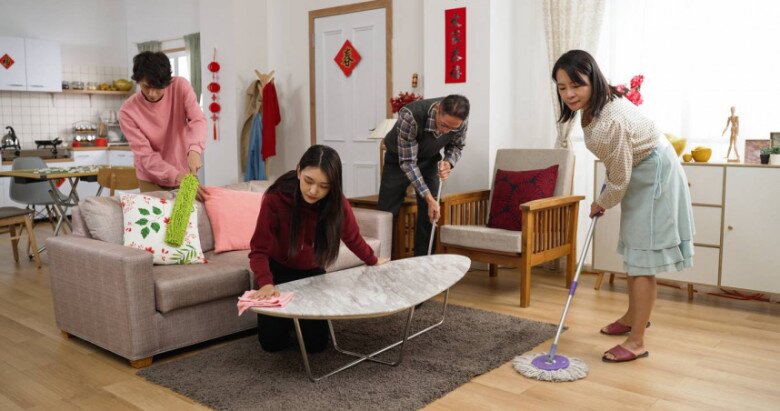
1. Clean bed linens and pillows
According to studies, if pillowcases are not washed within a week, the number of bacteria can reach up to 3 million, 17,000 times more than the surface of a toilet seat. Bed linens, which come into direct contact with the body, should also be washed at least once every 1-2 weeks. To make cleaning easier, you can add a cup of white vinegar and salt to the laundry to remove odors, stubborn stains, and kill bacteria more effectively.
2. Do laundry
Doing laundry is an art that requires subtlety. To keep clothes from becoming misshapen or discolored, you need to choose the right detergent and washing method for each fabric type. When doing laundry, add a bowl of white vinegar to the wash. When drying, hang clothes according to their thickness and fabric type to increase drying speed.
3. Clean rugs
Rugs have become an integral part of bedroom and living room decor. However, cleaning rugs when they are stained with spilled drinks or pet hair can be challenging. In addition to professional rug cleaning services, you can use baking soda or salt to treat stains without needing to scrub too much.
4. Clean floors
Many people sweep the floors regularly but still find them dirty. To reduce the effort of cleaning, simply mix 5-6 drops of fabric softener into half a bucket of water; this solution will help reduce static electricity. Just mop the floors once a month with this solution to keep them clean.
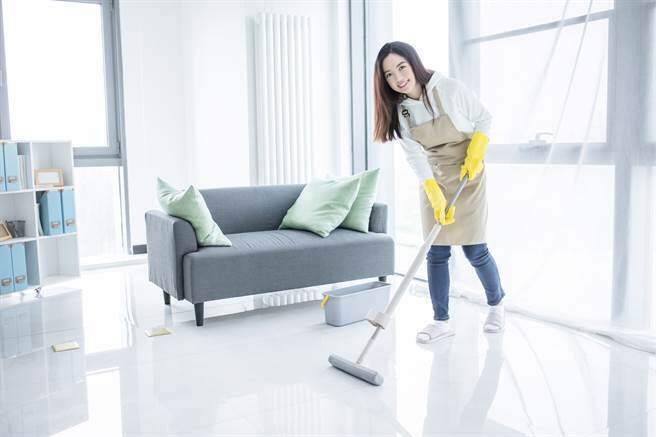
5. Cleaning tools
To save costs and protect your family’s health, you can try using natural ingredients like sodium bicarbonate, baking soda, or citric acid instead of chemical cleaners. Even seemingly useless ingredients like salt, coffee grounds, or eggshells can become powerful allies in household cleaning.
Apply these tips to keep your living space clean and comfortable!
The Ultimate Guide to Removing Black Mold from Your Sink and Toilet: A Step-by-Step to a Sparkling Clean
When it comes to spring cleaning, I was shocked to discover just how many dead angles there were in my home! The kitchen sink and bathroom toilet rims were stained with mysterious black marks that even a good scrub with a steel brush couldn’t remove. It was a concerning find and made me realize the importance of tackling these often-overlooked areas.

